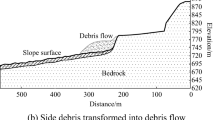Abstract
Large spoil tips from reconstruction works as a result of the Wenchuan Earthquake in China are new debris flow hazards to the human society. However, there is a lack of detailed comparative study on debris flow initiation in different spoil materials. This paper describes a series of tests and analyses on debris flow characteristics (initiation, scale and mechanism) at six sites with limestone and sandstone materials near the Dujiangyan area. Research shows the limestone spoil contains debris flow prone clay content with high concentration of montmorillonite (highly expandable). In addition, limestone spoil is of such a low permeability that water mainly concentrates in the upper surface layer. Those factors make it easy for the increase of pore water pressure, decline of internal friction and conhesion force, leading to the occurence of large debris flows. In contrast, the sandstone spoil is less problematic and causes no major debris flow threats. Based on our research on the mechanism, the“stereometric drainage”method is sucessfully applied to control limestone spoil debris flows.
Similar content being viewed by others
References
Beroya MAA, Aydin A, Katzenbach R (2009) Insight into the effects of clay mineralogy on the cyclic behavior of silt-clay mixtures. Engineering Geology 106:154–162.
Bishop AW (1973) The stability of tips and spoil heaps. Quarterly Journal of Engineering Geology 6: 335–376.
Chen NS (2006) Debris flows and confluence process research. Graduate University of Chinese of Sciences. (In Chinese)
Chen NS, Zhou W, Yang CL, et al. (2010a) The processes and mechanism of failure and debris flow initiation for gravel soil with different clay content. Geomorphology 121(3): 222–230.
Chen NS, Zhou W, Yang CL, et al. (2010b) Prevention and control mode of construction spoils-induced debris flow hazards and its application. Mining Research and Development 30(4): 84–87. (In Chinese)
Cui CC, Chen NS, Wang YH, et al. (2010) Characteristics and prevention strategy of spoil debris flow long new-built Puyang-Hongkou Highway in earthquake-stricken area. Journal of Geological Hazards and Environment Preservation 21(2): 7–10. (In Chinese)
Dolinar B, Trauner L (2007) The impact of structure on the undrained shear strength of cohesive soils. Engineering Geology 92: 88–96.
Iverson RM, Denlinger RP, LaHusen RG, et al. (2002) Twophase debris-flow across 3-D terrain: Model predictions and experimental tests. Proceedings of the second international conference on debris-flow hazards mitigation: 521–529.
Iverson RM, Lahusen RG (1989) Dynamic pore-pressure fluctuation in rapidly shearing granular material. Science 246: 796–799.
Iverson RM, Reid ME, LaHusen RG (1997) Debris flows mobilization from landslides. Annual review of earth and planetary science 25: 85–138.
Liu F, Tang HM (2011) Developing process of debris flow on slope of engineering slag. Journal of Chongqing Jiaotong University (Natural Science) 30(21): 519–522. (In Chinese)
Liu L, Chen HK (2009) Causes of mine debris flow disaster and its countermeasures. Journal of Chongqing Jiaotong University (Natural Science) 28(5): 915–920. (In Chinese)
Ni HY, Tie YB, Su PC (2011) Classification and disaster prevention system of debris flows induced by waste dumps. Resources & Industries 13(3):103–109. (In Chinese)
Oztoprak S, Pisirici B (2011) Effects of micro structure changes on the macro behaviour of Istanbul (Turkey) clays exposed to landfill leachate. Engineering Geology 121: 110–122.
Ran YK, Xu XW, Chen WS, et al. (2010) Paleo earthquake and large earthquakes recurrence interval along Yingxiu-Beichuan fault of the Longmenshan fault zone, Sichuan, China. Recent Developments in World Seismology 6: 28–29.
Ransom B, Helgeson HC (1994) A chemical and thermodynamic model of aluminous dioctahedral 2:1 layer clay minerals in diagenetic processes: regular solution representation of interlayer dehydration in smectite. American Journal of Science 294: 449–484.
Sassa K, Wang GH (2005) Mechanism of landslide-triggered debris flows: Liquefaction phenomena due to the undrained loading of torrent deposits. In: Matthias Jakob, Oldrich Hungr, Debris-flow Hazards and Related Phenomena, Springer, Chichester, UK: 81–104.
Siddle HJ, Wright MD, Hutchinson JN (1996) Rapid failures of colliery spoil heaps in the South Wales Coalfield. Quarterly Journal of Engineering Geology 29: 103–132.
Wang JH (1995) Structure and expand of clay mineral. Journal of Anqing teachers College (Natural Science Edition) 1(4): 14–16.
Xu YN (2008) Investigation and research on the mine geological environment: present status and outlook. Geological Bulletin of China 27(8):1235–1244. (In Chinese)
Xu YN, Chen SB, He F (2006) Mullock type debris flow hazards and suggestions for prevention in Tongguan Gold Mine Area. Journal of Mountain Science 24(6): 667–671. (In Chinese)
Zhang YS, Jin YM, Wu SR, et al. (2005) Dynamics of debris flow caused by human waste-dump: a case study of the Huangjia Valley in Badong County of the Three Gorges Region. Acta Geoscientica Sinica 26(6): 571–576. (In Chinese)
Author information
Authors and Affiliations
Corresponding author
Rights and permissions
About this article
Cite this article
Chen, Ns., Lu, Y., Deng, Mf. et al. Comparative study on debris flow initiation in limestone and sandstone spoil. J. Mt. Sci. 10, 190–198 (2013). https://doi.org/10.1007/s11629-013-2594-8
Received:
Accepted:
Published:
Issue Date:
DOI: https://doi.org/10.1007/s11629-013-2594-8




